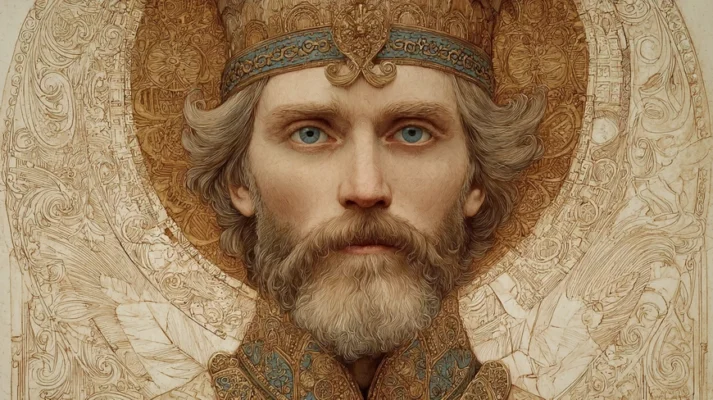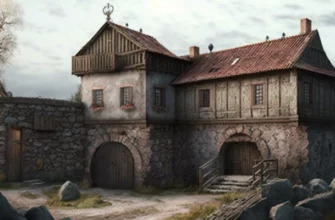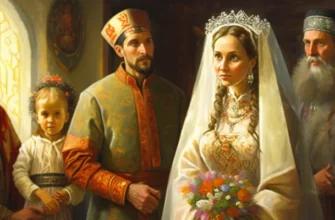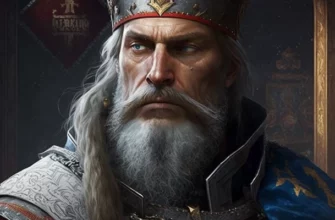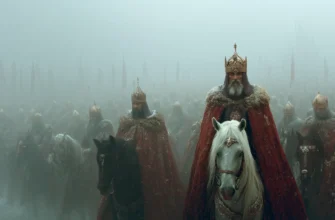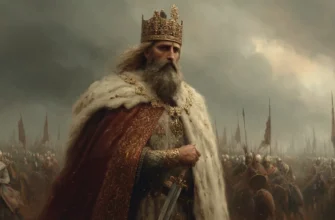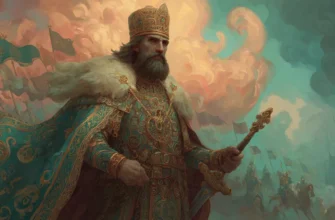Kniaz Oleh the Prophetic was one of the most famous rulers of early Kyivan Rus, who played a key role in the formation of the statehood of the Eastern Slavs. His reign lasted from the late 9th to the early 10th century.
Oleg came from the Rurikovich dynasty and was a relative of Prince Rurik. After Rurik’s death, he became the guardian of his young son Ihor and the de facto ruler. In 882, Oleg captured Kyiv, uniting Novgorod and Kyiv under his rule, which became the basis for the creation of a unified Kyivan Rus. That is why he is considered the founder of this state.
One of Oleg’s most famous feats was his campaign against Constantinople (Tsargrad) in 907. According to legend, he nailed his shield to the city’s gates as a sign of victory. As a result, a favorable trade agreement was concluded with Byzantium, which strengthened the international position of Rus.
The prince received the nickname “The Prophetic” because of the prophecies attributed to him by chroniclers. According to legend, he learned from soothsayers that he would die from his horse, so he ordered it killed. But later, when he visited the place where the animal’s bones were lying, Oleg stepped on the skull and was bitten by a snake. Thus the prophecy came true.
Oleg the Prophetic left a deep mark on the history of Kievan Rus. His image combines the traits of a wise statesman, a brave warrior, and a mystical seer, making him not only a historical figure but also a legendary one.ContentsHistorical origin of OlegRole in the formation of the statehood of RusUnification of northern and southern landsCentralization of powerConquest of neighboring tribesEstablishment of diplomatic relationsTransfer of the capital to KyivCapture of KyivUnification of lands around KyivConquest of local tribesMilitary campaigns and foreign policyThe campaign against Tsargrad (907)Trade agreement with ByzantiumThe legend of the nailed shieldRelations with ByzantiumProphecies and the image of the “prophet”Prophecy of one’s own deathThe image in chronicles and folkloreConclusionsContents.
- Historical origin of Oleg
- Role in the formation of the statehood of Rus’
- Unification of northern and southern lands
- Centralization of power
- Conquest of neighboring tribes
- Establishment of diplomatic relations
- Moving the capital to Kyiv
- Capture of Kyiv
- Unification of lands around Kyiv
- Conquest of local tribes
- Military campaigns and foreign policy
- The campaign against Tsargrad (907)
- Trade agreement with Byzantium
- The legend of the nailed shield
- Relations with Byzantium
- Prophecies and the image of the “prophetic”
- A prophecy about his own death
- The image in chronicles and folklore
- Conclusions
Historical origin of Oleg
The historical origin of Kniaz Oleg the Great is still the subject of scientific debate. According to the Tale of Bygone Years, he was a Varangian and belonged to the wife of Prince Rurik, the legendary founder of the Rurik dynasty. After Rurik’s death in 879, Oleg became the guardian of his son Igor and the de facto ruler of Novgorod.
Historians assume that Oleg could have been a relative of Rurik’s, possibly a brother or close associate. His name is of Scandinavian origin – from the Old Norse Helgi, which means “holy” or “sacred.” This further confirms his connection with the Varangian (Norman) environment.
However, there are alternative views in Ukrainian historiography, according to which Oleh could have been of local, Slavic, or Slavic-Scandinavian origin. In any case, he was the figure who laid the foundations of Kievan Rus as a centralized state.
His abilities as a commander, politician, and strategist allowed him to unite the northern and southern Slavic tribes under the rule of Kyiv, which was crucial for the development of medieval Rus.
Role in the formation of the statehood of Rus’
Kniaz Oleg the Prophetic played a crucial role in the formation of Kievan Rus as the first centralized state of the Eastern Slavs. His actions laid the foundations for political unity, territorial unification, and international recognition of Rus.
Unification of northern and southern lands
In 882, Oleg marched from Novgorod to the south, captured Kyiv and proclaimed it the “mother of Russian cities.” He united the two main centers – Novgorod and Kyiv – under a single authority, which was the beginning of the formation of a unified state. This unification put an end to the fragmentation of East Slavic tribes.
Centralization of power
Oleg established a princely administration in Kyiv, subordinated local princes, and strengthened his control over the lands under his rule. He actively used the vigilante system, relying on a military elite loyal to him.
Conquest of neighboring tribes
During his reign, Oleg conquered a number of Slavic and Finno-Ugric tribes – Drevlyans, Northerners, Radymen, Tiverts, and others. This not only expanded the territory of the state, but also provided a stable source of tribute.
Establishment of diplomatic relations
Oleg signed a favorable treaty with Byzantium after a successful campaign against Constantinople in 907. This treaty cemented the international recognition of Rus as a state and facilitated the development of trade and diplomacy.
Thanks to these actions of Oleg the Great, Kievan Rus emerged as a powerful state with centralized power, a stable territorial structure, and weight in the international arena. His rule became the foundation for the further development of statehood on Ukrainian lands.
Moving the capital to Kyiv
One of the most important events of the reign of Prince Oleg the Great was the transfer of the capital from Novgorod to Kyiv in 882. This step was of great political and strategic importance and became the key to the formation of Kyivan Rus.
Capture of Kyiv
In 882, Oleg set out on a campaign from Novgorod to the south, taking with him an army of Varangians and Slavs. At that time, Kyiv was ruled by Askold and Dir, Vikings who did not belong to the Rurik family. According to the chronicle, Oleh tricked them out of the city and executed them, proclaiming Kyiv “the mother of Russian cities.”
Reasons for moving the capital
Geographical location: Kyiv is located in the center of the trade route “from the Varangians to the Greeks,” which made it convenient for controlling trade between the North and Byzantium.
Political benefit: Kyiv was closer to the southern Slavic tribes, which needed to be united under a prince.
Military strategy: The south had a milder climate, more resources, and was more convenient for managing vast lands.
The relocation of the capital made it possible to unite the northern and southern lands of Rus’ under a single authority, which became the basis for the creation of a centralized state. Kyiv became not only the political, but also the economic and cultural center of Rus’, retaining this importance for several centuries.
Thus, moving the capital to Kyiv was a strategically wise decision by Oleg, which determined the further development of Ukrainian statehood.
Unification of lands around Kyiv
After the capture of Kyiv in 882, Prince Oleg the Prophetic began an active policy of uniting the surrounding Slavic lands under his rule. This process became a key stage in the creation of a centralized Kyivan Rus.
Conquest of local tribes
Oleg conquered several important East Slavic and Finno-Ugric tribes:
Drevlyans
Severians
Radimichi
Tivertsi
Ulichs.
These tribes were obliged to pay tribute to Kyiv, which provided a stable income for the state and strengthened its economy.
Oleg not only annexed territories by force, but also established political control by appointing his own governors or making deals with local nobility. This contributed to the strengthening of centralized power.
The unification of the lands around Kyiv allowed for a more unified system of tribute collection (poludya), the organization of military service, and the development of trade between the regions.
The unification of the surrounding lands became the basis for the formation of Kyivan Rus as a state. Thanks to Oleg’s actions, Kyiv became not only the capital but also a real center of political power, uniting different tribes into one political community for the first time.
Military campaigns and foreign policy
Kniaz Oleh the Prophetic was not only a skillful ruler but also a talented commander and diplomat. His military campaigns and foreign policy significantly strengthened the international position of Kievan Rus and contributed to its economic growth.
The campaign against Tsargrad (907)
Oleg’s most famous military success was the campaign against Constantinople (Tsargrad) in 907. According to the Tale of Bygone Years, the prince brought a huge army and even used ships on wheels to bypass the Greek chains that blocked the entrance to the harbor.
The main purpose of the campaign was:
To secure the economic interests of Russia on the Black Sea coast
To obtain favorable terms of trade with Byzantium
Strengthen the international authority of the Kyivan state
According to the Tale of Bygone Years, Oleg gathered a large army of Varangians and Slavs and marched south. The Russian army approached Constantinople from both land and sea. To circumvent the harbor’s defenses, the Rus’ put their ships on wheels and dragged them overland to the city walls. This caused panic among the Byzantines.
After the Greeks agreed to negotiate, Oleg nailed his shield to the gates of Tsargrad as a symbol of victory and humiliation of the enemy. This gesture became legendary and is mentioned in chronicles as proof of the prince’s strength and glory.
Conclusion of a favorable treaty with Byzantium (written version in 911): Russian merchants were allowed to trade in Byzantium without paying duties, to winter in Greek cities, and to receive food and aid.
International recognition of Rus as a powerful force in the European arena
Strengthening of Oleg’s authority as a wise and far-sighted ruler
The campaign against Tsargrad in 907 is not only an example of military skill, but also of successful diplomacy. It was the first major demonstration of Kievan Rus’ strength at the international level and one of the most striking episodes in the history of the reign of Prince Oleg the Great.
After the siege, the Greeks were forced to make peace and agree to favorable terms for the Rus’. The symbol of the victory was the nailing of Oleg’s shield on the gates of Constantinople.
Trade agreement with Byzantium
In 911, an official written trade treaty was signed between Rus and Byzantium, one of the first in the history of Rus.
This treaty guaranteed:
Safe trade for Russian merchants in Byzantium
The right to spend the winter in Greek cities
Mutual legal responsibility of both parties
Exchange of embassies
This testified to the recognition of Kievan Rus as an equal partner in international relations.
Relations with neighboring tribes and states
Oleg also pursued an active foreign policy in the eastern direction:
He conquered some of the Finno-Ugric tribes.
Strengthened control over the East Slavic lands
Maintained relative stability on the northern borders, in particular in relations with the Khazar Khaganate
Oleg the Great’s foreign policy was characterized by a combination of force and diplomacy. His successful military campaigns and peace agreements laid the foundation for the economic development of Kievan Rus and its recognition as a powerful state in the international community.
The legend of the nailed shield
One of the most famous and symbolic episodes in the life of Prince Oleg the Great is the legend of the shield nailed to the gates of Constantinople after a successful campaign in 907.
According to the Tale of Bygone Years, after a victorious campaign against Byzantium, Oleg forced the Greeks to make peace and agree to favorable terms for Rus. To emphasize his superiority, the prince nailed his battle shield to the gates of the Byzantine Empire’s capital, Constantinople.
This gesture had great symbolic significance:
A sign of victory over a strong and wealthy opponent.
Demonstration of the power and strength of Kievan Rus
Political humiliation of Byzantium, which was forced to recognize the power of its northern neighbor
Although the chronicle is full of drama and symbolism, many historians consider it more legendary than documented. There is no direct mention of the campaign of 907 or the nailed shield in Byzantine sources. However, such a legend had an important ideological function: it glorified the prince as a powerful and victorious ruler who not only fought but also humiliated his enemies.
The legend of Oleh’s shield has been fixed in historical memory as a symbol of Rus’ triumph over a powerful empire. It became a part of folklore, chronicle tradition, and the image of Oleg himself-not only as a real prince, but also as a legendary hero with prophetic powers.
Thus, even if this episode is a literary fiction, it reflects the ancient Rus’ perception of the strength, honor, and dignity of their prince.
Relations with Byzantium
Relations between Kyivan Rus and the Byzantine Empire under Prince Oleg the Great were among the most important in the state’s foreign policy, combining military clashes with diplomacy and trade.
In 907, Oleg led a successful campaign against Constantinople, which ended in a peace treaty. This campaign demonstrated the military power of Rus’ and forced Byzantium to treat its northern neighbor with respect.
In 911, the first written treaty between Rus and Byzantium was signed. This document guaranteed:
Security of Russian merchants in Byzantium
The right to free trade without paying excessive duties
The opportunity to spend the winter in Greek cities
Mutual protection and legal norms for both sides
Exchanges of embassies between the two states testified to the recognition of Kievan Rus as an equal participant in international relations. This helped maintain peace and fostered cultural contacts.
Relations with Byzantium under Oleg the Great not only strengthened the economy of Rus, but also increased its authority on the world stage. They laid the groundwork for further cooperation, in particular during the baptism of Rus in the time of Prince Volodymyr.
Thus, Oleg’s policy towards Byzantium was balanced, combining force and diplomacy, which ensured long-term peace and development of the state.
Kniaz Oleg the Prophetic made a significant contribution to the rise of the status of Kievan Rus in the international arena, transforming it from an association of tribes into an influential state recognized by neighbors and distant powers.
The signing of the first written trade treaty with the Byzantine Empire in 911 officially cemented Rus’ status as an equal partner in international relations. This document became one of the first evidences of a diplomatic culture in Russia.
Thanks to peaceful and profitable trade agreements with Byzantium and other nations, Russia strengthened its economy, which further increased its importance on the international stage.
The legend of the nailed shield on the gates of Tsargrad became a powerful symbol of the power and authority of Prince Oleg and all of Rus, strengthening its prestige in the minds of its neighbors and its own subjects.
Thanks to these actions, Oleg the Prophetic laid the foundation for the further strengthening of Kievan Rus as a powerful and influential state that successfully interacted with the largest empires of his time.
Prophecies and the image of the “prophetic”
Kniaz Oleh was nicknamed “Vishchyi” (prophetic) because of legends related to his ability to predict the future and act on prophecies.
The legend of Oleg’s death
The most famous legend is the story of a prophecy to Oleg that predicted his death by a horse. According to the legend, Oleh ordered doctors to kill his war horse to protect himself from a threat, but years later, when he was checking the horse’s skull, he suddenly hit it and was fatally injured. Thus the prophecy was fulfilled.
The image of the prophetic prince emphasizes not only his wisdom but also his special connection with fate and the spiritual world. In medieval ideas, prophetic people had the gift of foresight, which made them authoritative and almost mystical figures.
The nickname “The Prophetic” served to reinforce Oleg’s authority as a ruler who not only possessed power but also understood the “will of the gods” or “fate,” which gave his actions a sacred meaning.
The image of Oleg the Prophet as a prophet and wise ruler has been preserved in history as a symbol of the combination of power, wisdom, and incomprehensible fate that determined his role in the formation of Kievan Rus.
The nickname “Prophetic” – meaning and origin
Kniaz Oleg’s nickname “Vishchiy” means ‘prophetic’, “one who sees the future” or “one who has the gift of augury”. This word comes from the Old Slavic root “veschat” – to predict, to prophesy.
The nickname “Prophetic” is associated with legends and tales that emphasize Oleg’s ability to foresee events that were especially important for his reign. The most famous story is a prophecy about his death related to a horse, which came true shortly after the prince tried to avoid this fate.
Recognition of wisdom and foresight: Oleg is portrayed not only as a warrior and a ruler, but also as a person with a special understanding of fate and events.
Increasing authority: In medieval society, the image of a soothsayer gave power a sacred connotation and strengthened the position of the ruler.
A symbol of connection with the spiritual world: the nickname hints at the special spiritual status of the prince, his ability to predict and influence the course of history.
Thus, the nickname “Prophetic” became an important element of Prince Oleg’s identity, emphasizing his role as a wise and foresighted leader of Kievan Rus.
A prophecy about his own death
One of the most famous and mysterious legends associated with Prince Oleg is the prophecy of his own death.
According to legend, Oleg received a prophecy that he would die because of a horse. In order to avoid this fate, the prince ordered his war horse to be killed and moved away. He believed that in this way he would protect himself from death.
However, many years later, when Oleh was already an old man, he wanted to see his horse’s skull. When he touched it, the prince suddenly received a fatal wound-according to one version, a bone or shield attached to the skull wounded him. Thus, the prophecy was fulfilled, and the prince died from the horse he was trying to protect himself from.
A symbol of the inevitability of fate: this story emphasizes the idea that one cannot escape one’s fate, even if one has foresight.
The image of a wise but doomed ruler: Oleg is shown as a man who knew his future but could not change it.
Mystical halo: the prophecy adds a special mystical meaning to the image of the prince, making him a figure that combines reality and legend.
The prophecy about Oleg’s death became an integral part of his historical image, emphasizing the drama and mystery of his reign in the history of Kievan Rus.
The image in chronicles and folklore
The image of Oleg the Great is firmly entrenched in the historical memory of Ukrainians and Russians thanks to chronicles and folk tales. He combines the traits of a wise ruler, a brave warrior, and a mystical soothsayer.
In The Tale of Bygone Years, Oleg appears as:
An outstanding military leader who united the lands of Russia
A far-sighted politician who moved the capital to Kyiv
A wise ruler who concluded important treaties with Byzantium
A prophetic prince who foresaw events, including his own death
The chronicle’s depiction of Oleg emphasizes his role as the founder of the state and symbolizes the beginning of a new era in the history of Rus.
In folk tales and epics, Oleg often appears as:
A legendary hero capable of amazing feats
A sage and prophet with the gift of prophecy
The image of an indomitable ruler who controls his fate and state
Folklore stories often contain mystical elements, emphasizing the prince’s connection to fate and higher powers.
The image of Oleg the Great combines historical facts and legends, creating a vivid portrait of one of the most influential rulers of Kievan Rus, who left a deep mark on the culture and history of Eastern Europe.
Conclusions
Kniaz Oleg the Prophetic played a crucial role in the formation of Kievan Rus as a powerful state. It was he who established Kyiv as the capital, which became the political center of the unification of the East Slavic lands. The unification of the territories around Kyiv helped to create a single state structure. The prince’s successful military campaigns and diplomacy strengthened Rus’ international authority, opening up new opportunities for trade and cultural exchange. Thanks to the signing of the first diplomatic treaties with Byzantium, Kievan Rus received a model of foreign policy relations that developed under subsequent rulers. The image of Oleh as a wise and prophetic prince became a symbol of an ideal ruler and significantly influenced the political culture.
Thus, Kniaz Oleg the Prophetic is one of the most prominent figures in the history of Kievan Rus. His activities combined military power, diplomatic skill, and the mystical aura of a prophet. Thanks to his rule, Kyiv became the center of a powerful state that played an important role in European politics. Rus cemented its place in the international arena through important trade and political ties, and the legends of Oleg created a strong cultural heritage that inspired subsequent generations. His reign marked the beginning of a new era in the history of Eastern Europe – the era of Kievan Rus as a strong, united, and influential state.
The activities of Kniaz Oleg the Great are of fundamental importance for the history of Ukraine, because it was he who laid the foundations of a powerful state in Eastern Europe. Oleh united the scattered East Slavic tribes, moved the capital to Kyiv, and thereby established a center of political power that became the core of the future Kyivan Rus, the first great state on the territory of modern Ukraine. His successful military campaigns and diplomatic agreements, especially with Byzantium, raised the international prestige of Rus, promoted the development of trade and culture, and laid the traditions of diplomacy. The image of Oleh as a wise and visionary ruler became an important component of national historical self-determination and cultural memory. Thus, Oleg the Prophetic not only strengthened the political and economic positions of the early Ukrainian state, but also created a solid foundation for its further development, which determined the course of Ukraine’s history for centuries to come.
